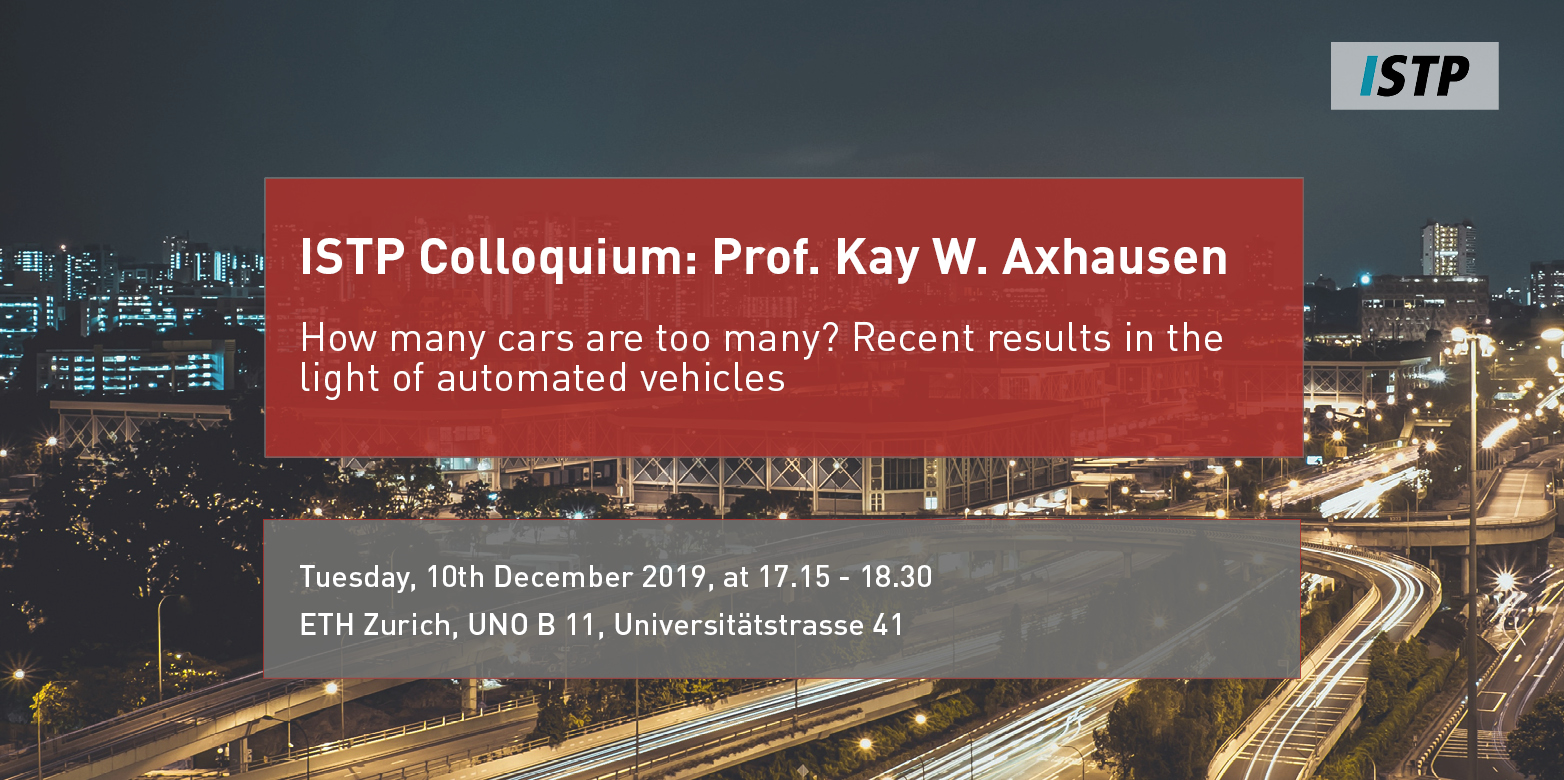How many cars are too many? Recent results in the light of automated vehicles.
We would like to warmly thank Prof. Kay W. Axhausen, Professor of Transport Planning at the Institute for Transport Planning and Systems at ETH Zurich, for his visit to the ISTP and his talk about the key dilemma of today’s transport policy.
by Andreas Eckmann

Introduction - Definition of the Problem
Transport is a system of moving queues and their servers with elastic demand. People want to buy more of it if capacity is added. Therefore, it feels like we can’t win it. Prof. Axhausen comes to the problem right away: mobility is self-energizing. However, there is only limited space available. The presented results from studies in Switzerland explain the complexity of the problem.
Often, cars are faster than the alternatives by a factor of three. The richer we become, the more cars we have. As society catches up, there will be more cars in use. In cities like Jakarta (Indonesia), cars are becoming slowly moving air-conditioning units, barely faster than walking speed. So, cars are cooling (or heating) units in some areas. But why the dilemma? To answer this question, Prof. Axhausen points out accessibility as the key element. With increasing accessibility, productivity and welfare increase. But so does car ownership and urban sprawl, leading to a decrease in transit season ticket ownership and increased distance by car (pkm, passenger kilometer), respectively. Both are resulting in increased CO2 emissions. And since the infrastructure network is relatively static, the productivity gains from accessibility increase cannot be ensured. Even with level five autonomous vehicles (AVs) there are serious issues arising, which require a careful study.
Prof. Axhausen Group's Research
To tackle the described dilemma, reliable prediction models are required. To control congestion and minimize social travel time, the optimal location of network points is needed. How many cars should be let into the system? At what interval? Since an agent-based model would require huge computational time, Prof. Axhausen and his group tackle the problem of simulating accessibility with simpler models. As a measure of network capacity, macroscopic fundamental diagrams (MFDs) are used. The output is speed, because the higher the capacity the faster one can travel. This closes the loop, as speed defines accessibility again.
A key message that Prof. Axhausen points out is, that the higher the transit accessibility is (i.e. the easier it is to travel with public transport), the less cars people own. The Spatial error model shows that in areas with high accessibility (for car and public transport), people’s income is higher. Given the fact that society invests in transport infrastructure to increase accessibility, one could conclude that such investment will do the job. But a system like the one in Switzerland is already very well developed, meaning that additional investment will result in smaller change compared to investing in Jakarta’s system. Adding more road space brings only very little help but adds much higher costs. As the number of passengers goes up, the mode used changes. With relatively low passenger accumulation, the car is the way to go. As the number increases, one (i.e. a city transport planner) should start adding buses and lots of bicycles. With very high numbers, buses are taking over the biggest part – otherwise the described example from Jakarta is the outcome. Although buses are a bottleneck when it comes to traffic flow (they move slowly and stop repeatedly), their capacity gain outweighs the flow losses.
When it comes to AVs, the future development is very uncertain. Often, AVs are sold as the solution to everything: They will increase capacity by reducing travel time and congestion. Prof. Axhausen makes clear that he and his team don’t really believe that. There are several unanswered questions, which require clarification from society: What market structure (monopoly, oligopoly, dispersed) do we want? What is the role and extent of public transport? What is the system target (system optimum, user equilibrium)? What type of traffic system manager do we need? What’s the share of autonomous vehicles and how is the road space allocated?
Prof. Axhausen’s group ran models to find out how many empty miles a fictional dispatcher has produced. They used the developed tool to calculate the price which a taxi fleet need to charge to fully fund itself from revenue. Then they updated the price for the next iteration until the number of taxis (i.e. the fleet) matches the price. The results show that taxis will be as expensive as private AVs. And since people only look at the variable costs of a car (i.e. neglecting the loss of value of a car when traveling), private AVs will swamp out everything else, wiping out the taxi industry and leaving them with a niche market, if not subsidized or regulated otherwise.
Future Research
So, what should we do next then? Prof. Axhausen introduces multiple potential future work topics. We still have the chance to influence further development. In the case of AVs, more work on the acceptance of AV is required. Meanwhile, studies are needed, inter alia, on future costs / prices by type of operator, on the efficiency of the fleets (empty km, parking, drop off / pick up, rebalancing, dispatch), on how to achieve system optimum with fleet operators, on the future of "public transport", on the impact of automation on urban form (e-commerce) and productivity, or on the structure of electric AV fleets to cope with long distance travel to close the research gap.
To get a broadened sense of the ISTP and our topics of interest and past seminars visit our Colloquium page.